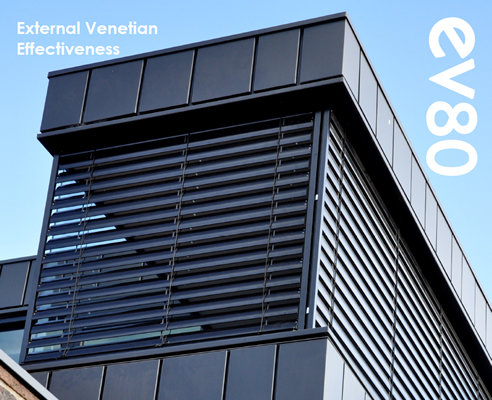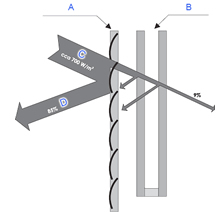External Venetian Blind Effectiveness from Evaya

EFFECTIVENESS OF EXTERNAL VENETIAN BLINDS
 Assessing the impact of window blinds on levels of heat gain through glass.
Assessing the impact of window blinds on levels of heat gain through glass.
Heat gains that occur within internal
spaces can be classified on the basis
of their origin. These may result directly
from internal sources of heat or from the
external environment.
A External Blinds - Slats angled at 45 degrees
B Double Glazing
C Sun's Radiation
D Reflection
Heat sources produce thermal energy which
acts to directly increase air temperature.
This thermal load may be absorbed by
water vapour.
Internal sources of heat gain production
include, but are not limited to, body heat,
lighting, machinery and heat passage
between rooms.
Heat gains from the external environment
are caused by the passage of solar radiation
through mediums and structures such as
walls, ceilings, glazed window surfaces,
doors and the infiltration of external air.
External Heat Gains have a decisive impact
on the thermal load of buildings. Window
design, surface area and orientation are all
factors which affect this loading dramatically.

External versus Internal Shading Systems
Many reputable studies have been
conducted into the efficiency of external
and internal shading systems. Most of the
research has been carried out in Europe
where high energy costs make effective
insulation of glass areas a must - in fact
some countries have tough legislation in
place against energy inefficiency.
Research findings by Australian Institutions
and summary figures are available through
CSIRO.
The objective with any shading device is of
course to keep the inside temperature in a
range where our bodies feel comfortable
and perform at their best.
It has been well established that these
temperatures are ranging between 18° and
25° Celsius.
To achieve and maintain this comfort
zone we have to spend valuable energy
into cooling and heating our homes and
workplaces.
Shading & Insulation
External shading systems that also act as
barriers against cold winter nights, will save
money in 2 ways:
1. The upfront investment into a smaller
cooling and heating unit.
2. Ongoing savings in running and
maintenance costs.
In case of an environmentally friendly
design, cooling or heating may not even be
necessary by using external shading and
insulation devices (Olympic Village Design).

|



 Assessing the impact of window blinds on levels of heat gain through glass.
Assessing the impact of window blinds on levels of heat gain through glass.



 Features of External Venetian Blinds by
Features of External Venetian Blinds by Blackout Blinds for Bedrooms by evaya
Blackout Blinds for Bedrooms by evaya Non-Combustible External Blinds by evaya
Non-Combustible External Blinds by evaya How to Clean External Venetians by evaya
How to Clean External Venetians by evaya Why External Venetian Blinds by evaya
Why External Venetian Blinds by evaya Glare Solution for Windows by evaya
Glare Solution for Windows by evaya External Venetians Supplier VIC by evaya
External Venetians Supplier VIC by evaya Maintenance for External Venetians by
Maintenance for External Venetians by Outdoor Venetian Blinds with Shroud
Outdoor Venetian Blinds with Shroud External Blinds for Bathrooms by evaya
External Blinds for Bathrooms by evaya Evaya's New Website and Gallery
Evaya's New Website and Gallery External Venetians for Modern Farmhouse
External Venetians for Modern Farmhouse Versatile ev80 External Venetians from
Versatile ev80 External Venetians from ev93D External Venetians for Light
ev93D External Venetians for Light EV80 & EV93D External Shading
EV80 & EV93D External Shading BCA Compliant External Venetian Blinds
BCA Compliant External Venetian Blinds Effectiveness of External Venetians by
Effectiveness of External Venetians by Adaptable External Venetian Blinds ev80
Adaptable External Venetian Blinds ev80 Automated Natural Light Management
Automated Natural Light Management Automated External Venetian Blinds by
Automated External Venetian Blinds by
